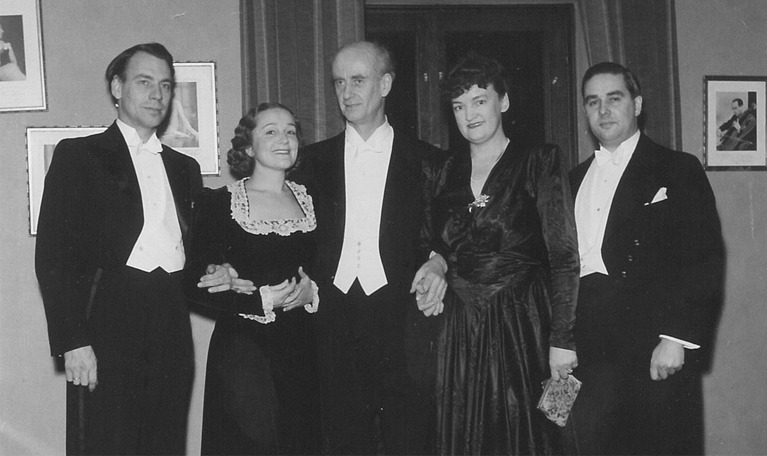The case of Wilhelm Furtwängler

Wilhelm Furtwängler with soloists at Konserthuset.
The great Wilhelm Furtwängler was close to becoming the Stockholm Concert Society’s chief conductor in the 1920s. The picture above is from the dressing room in Konserthuset. From left: Sigurd Björling, Hjördis Schymberg, Wilhelm Furtwängler, Lisa Tunell and Gösta Bäckelin. They were the soloists in Beethoven’s Symphony No. 9 in December 1943.
The German conductor Wilhelm Furtwängler (1886–1954) worked with the foremost orchestras of his day: the Vienna Philharmonic, Leipzig Gewandhaus Orchestra and the Berlin Philharmonic. Among the Berliners, he was a chief conductor for life. He also conducted the New York Philharmonic (1925–27), the Bayreuth Festival Orchestra (1931 and 1936–37) and the Covent Garden Orchestra (1937–38).
Furtwängler is interesting in several regards in terms of the history of the Stockholm Concert Society. From his debut in Stockholm in 1920, in Auditorium on Norra Bantorget, home of the orchestra until Konserthuset was ready in 1926, Furtwängler returned regularly to the Stockholm Concert Society, until his final appearances with the orchestra in 1948. Music by Beethoven or Brahms was frequently on the programme.
Furtwängler conducted the Stockholm Concert Society in an impressive nine concerts in 1920. Undeniably, the year 1920 stands out for its Furtwängler statistics. Meanwhile, conflict played out behind the scenes between the board and the chief conductor at that time, Georg Schnéevoigt.
In March 1920, negotiations were underway with Wilhelm Furtwängler to hire him as the new chief conductor of the Stockholm Concert Society. Spring culminated in tension arising from this process, and on 24 May 1921, at the Stockholm Concert Society association meeting, the old board was forced to resign while Schnéevoigt stayed on as the orchestra’s chief conductor.
Furtwängler returned to Stockholm Concert Society in 1921 (two concerts), 1925 (three concerts), 1941 (one concert), 1942 (five concerts), 1943 (four concerts), 1947 (three concerts) and finally in 1948 (four concerts). The final concert on 19 November 1948 offered Brahms’ A German Requiem – which had indeed also been Bruno Walter’s final concert with the Stockholm Concert Society two years later.
In September 1950, Furtwängler was back at Konserthuset, then with the guest-performing Vienna Philharmonic, and they began the first of two concerts with Du gamla, du fria, the Swedish national anthem.
